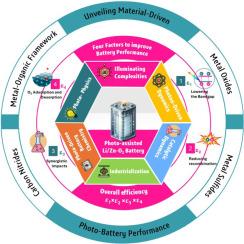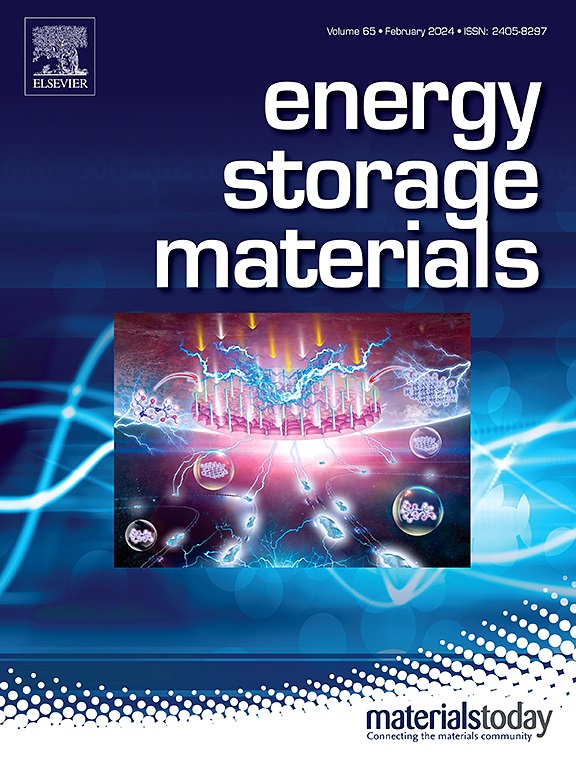Light-Driven Photocathodes in Li/Zn-O2 (air) Batteries: An Analytical Review, Technological Breakthroughs and Future Challenges
IF 18.9
1区 材料科学
Q1 CHEMISTRY, PHYSICAL
引用次数: 0
Abstract
The rapid advancement of renewable energy technologies has intensified the demand for high-performance energy storage systems. Metal-O2 (air) batteries, specifically Li-O2 (air) and Zn-O2 (air) variants, present exceptional theoretical energy densities, positioning them as promising candidates for next-generation storage solutions. However, significant challenges remain in optimizing the oxygen reduction and evolution reactions (ORR/OER), critical for achieving high efficiency and stability. Recent developments in light-assisted metal-O2 (air) battery designs leverage photonic energy to enhance oxygen reduction and evolution reactions, offering reduced charge voltages, improved round-trip efficiencies, and extended lifetimes. This review critically evaluates the breakthroughs and limitations in photo-assisted Li/Zn-O2 (air) battery technologies, with a focus on novel photocathode materials, including advanced semiconductors, heterojunction configurations, and nanostructured catalysts. We systematically highlight the key properties of these photocathode materials, evaluating their photon-utilization efficiency, charge separation capabilities, recombination rates, charging/discharging profiles, efficient decomposition of discharge products and stability under operational conditions. Emphasis is placed on advanced strategies to enhance light absorption, aiming to optimize photocatalytic efficiency, electronic properties, and catalytic stability, thereby overcoming current performance barriers. By providing a comprehensive analysis of the current landscape and emerging trends, this review aims to chart a path forward for the development of more robust, efficient, and sustainable light-assisted Li/Zn-O2 (air) batteries, highlighting the essential role of innovative photocathode materials in achieving next-generation energy storage solutions.

Li/Zn-O2(空气)电池中的光驱动光电阴极:分析回顾、技术突破和未来挑战
可再生能源技术的快速发展加剧了对高性能储能系统的需求。金属- o2(空气)电池,特别是锂- o2(空气)和锌- o2(空气)电池,具有卓越的理论能量密度,将其定位为下一代存储解决方案的有希望的候选者。然而,在优化氧还原和进化反应(ORR/OER)方面仍然存在重大挑战,这对实现高效率和稳定性至关重要。光辅助金属- o2(空气)电池设计的最新发展利用光子能量来增强氧还原和进化反应,从而降低充电电压,提高往返效率,延长寿命。本文对光辅助Li/Zn-O2(空气)电池技术的突破和局限性进行了批判性的评估,重点关注了新型光电阴极材料,包括先进的半导体、异质结结构和纳米结构催化剂。我们系统地强调了这些光电阴极材料的关键特性,评估了它们的光子利用效率、电荷分离能力、复合率、充放电曲线、放电产物的有效分解和在操作条件下的稳定性。重点放在提高光吸收的先进策略上,旨在优化光催化效率、电子性能和催化稳定性,从而克服当前的性能障碍。通过对当前形势和新兴趋势的全面分析,本综述旨在为开发更强大,高效和可持续的光辅助Li/Zn-O2(空气)电池指明前进的道路,强调创新光电阴极材料在实现下一代储能解决方案中的重要作用。
本文章由计算机程序翻译,如有差异,请以英文原文为准。
求助全文
约1分钟内获得全文
求助全文
来源期刊

Energy Storage Materials
Materials Science-General Materials Science
CiteScore
33.00
自引率
5.90%
发文量
652
审稿时长
27 days
期刊介绍:
Energy Storage Materials is a global interdisciplinary journal dedicated to sharing scientific and technological advancements in materials and devices for advanced energy storage and related energy conversion, such as in metal-O2 batteries. The journal features comprehensive research articles, including full papers and short communications, as well as authoritative feature articles and reviews by leading experts in the field.
Energy Storage Materials covers a wide range of topics, including the synthesis, fabrication, structure, properties, performance, and technological applications of energy storage materials. Additionally, the journal explores strategies, policies, and developments in the field of energy storage materials and devices for sustainable energy.
Published papers are selected based on their scientific and technological significance, their ability to provide valuable new knowledge, and their relevance to the international research community.
 求助内容:
求助内容: 应助结果提醒方式:
应助结果提醒方式:


